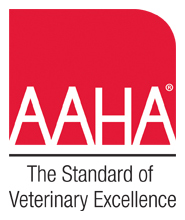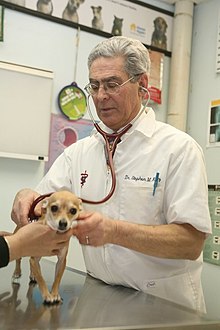
Veterinary medicine is the branch of medicine that deals with the prevention, management, diagnosis, and treatment of disease, disorder, and injury in non-human animals. The scope of veterinary medicine is wide, covering all animal species, both domesticated and wild, with a wide range of conditions that can affect different species.

A veterinarian (vet) is a medical professional who practices veterinary medicine. They manage a wide range of health conditions and injuries in non-human animals. Along with this, veterinarians also play a role in animal reproduction, health management, conservation, husbandry and breeding and preventive medicine like nutrition, vaccination and parasitic control as well as biosecurity and zoonotic disease surveillance and prevention.

The American Veterinary Medical Association (AVMA), founded in 1863, is a not-for-profit association representing more than 99,500 veterinarians in the US.
The Virginia–Maryland College of Veterinary Medicine is the veterinary school Virginia Tech and the University of Maryland, College Park - both of which are public research universities in the Commonwealth of Virginia and the State of Maryland, respectively.The college was created as a joint venture of the two universities and their respective state governments in order to fill the need for veterinary medicine education in both states. Students from both states are considered "in-state" students for admissions and tuition purposes.
A veterinary specialist is a veterinarian who specializes in a clinical field of veterinary medicine.

The U.S. Army Veterinary Corps is a staff corps of the U.S. Army Medical Department (AMEDD) consisting of commissioned veterinary officers and Health Professions Scholarship Program (HPSP) veterinary students. It was established by an Act of Congress on 3 June 1916. Recognition of the need for veterinary expertise had been evolving since 1776 when General Washington directed that a "regiment of horse with a farrier" be raised. It has evolved to include sanitary food inspectors and animal healthcare specialists.

Veterinary dentistry is the field of dentistry applied to the care of animals. It is the art and science of prevention, diagnosis, and treatment of conditions, diseases, and disorders of the oral cavity, the maxillofacial region, and its associated structures as it relates to animals.

Veterinary education is the tertiary education of veterinarians. To become a veterinarian, one must first complete a degree in veterinary medicine Doctor of Veterinary Medicine.
The Student American Veterinary Medical Association (SAVMA) is a national association of student chapters of the American Veterinary Medical Association (AVMA) at schools and colleges of veterinary medicine in the United States, Canada and the Caribbean. SAVMA acts as a single national voice for veterinary students in accordance with the policies and goals of the AVMA, coordinates AVMA student chapter activities, facilitates the exchange of information, and represents the interests of student veterinarians within AVMA, the veterinary profession and in the political and legislative arenas nationally.

The American Animal Hospital Association (AAHA) is a non-profit organization for companion animal veterinary hospitals. Established in 1933, the association is the only accrediting body for small animal hospitals in the U.S. and Canada. The association develops standards for veterinary business practices, publications, and educational programs. Any veterinary hospital can join AAHA as a member, but must then pass an evaluation in order to receive AAHA accreditation.
Veterinary anesthesia is a specialization in the veterinary medicine field dedicated to the proper administration of anesthetic agents to non-human animals to control their consciousness during procedures. A veterinarian or a Registered Veterinary Technician administers these drugs to minimize stress, destructive behavior, and the threat of injury to both the patient and the doctor. The duration of the anesthesia process goes from the time before an animal leaves for the visit to the time after the animal reaches home after the visit, meaning it includes care from both the owner and the veterinary staff. Generally, anesthesia is used for a wider range of circumstances in animals than in people not only due to their inability to cooperate with certain diagnostic or therapeutic procedures, but also due to their species, breed, size, and corresponding anatomy. Veterinary anesthesia includes anesthesia of the major species: dogs, cats, horses, cattle, sheep, goats, and pigs, as well as all other animals requiring veterinary care such as birds, pocket pets, and wildlife.
The Bachelor of Veterinary Science, "Bachelor of Veterinary Medicine" (BVetMed), or "Bachelor of Veterinary Medicine and Surgery" is a degree for studies in veterinary medicine in the United Kingdom, Australia, and several other countries outside the United States and Canada. These degrees qualify one to practice as a veterinarian in the US if the degree is conferred from an American Veterinary Medical Association (AVMA) accredited school and the candidate passes the North American Veterinary Licensing Examination (NAVLE), just as any other US and Canada graduate. They are equivalent to DVM/VMD degrees; the main equalizer being licensure in the US. On 5 March 2015, the Royal College of Veterinary Surgeons (RCVS) Council made the decision to allow UK veterinarians to use the courtesy title "doctor", to align with international practices. The RCVS president said of the change: “Whether one regards the decision as correcting a historical anomaly or simply providing greater clarity at home and abroad, there is no doubt that the issue has generated huge interest".
Ross University School of Veterinary Medicine (RUSVM), founded in 1982, is a university offering the Doctor of Veterinary Medicine degree. As of 2014, RUSVM began offering Master of Science and PhD degrees in public health, global animal health, conservation medicine, and other research areas supported by the school. The school is located in St. Kitts. Administrative offices are located in Downers Grove, IL. RUSVM is accredited by the American Veterinary Medical Association Council on Education.

Veterinary chiropractic, also known as animal chiropractic, is chiropractic for animals – a type of spinal manipulation. Veterinary chiropractors typically treat horses, racing greyhounds, and pets. Veterinary chiropractic is a controversial method due to a lack of evidence as to the efficacy of chiropractic methods. Contrary to traditional medicine, chiropractic therapies are alternative medicine. There is some degree of risk associated with even skilled manipulation in animals as the potential for injury exists with any technique used. The founder of chiropractic, Daniel David Palmer, used the method on animals, partly to challenge claims that the placebo effect was responsible for favorable results in humans. Chiropractic treatment of large animals dates back to the early 1900s. As of 2019, many states in the US provide statutory or regulatory guidelines for the practice of chiropractic and related treatments on animals, generally requiring some form of veterinary involvement.
Veterinary ethics is a system of moral principles that apply values and judgements to the practice of veterinary medicine. As a scholarly discipline, veterinary ethics encompasses its practical application in clinical settings as well as work on its history, philosophy, theology, and sociology. Veterinary ethics combines veterinary professional ethics and the subject of animal ethics. The subject of veterinary ethics can be interpreted as an extension of critical thinking skills necessary to make the decisions in veterinary care in order to support the profession's responsibilities to animal kind and mankind. There are five main topics that construct the physical usage of Veterinary Ethics. The first being history which describes how these ethics came to be, and how they have changed in the modernization of the veterinary industry. The second is the relation veterinary ethics has with human medical ethics, which together share many values. Third, the principles of these ethics which are updated regularly by the AVMA. Fourth are the key topics of veterinary ethics, which describe what these ethics cover. Last, how these ethics are incorporated into everyday practice and also how they affect those employed in the industry.

A paraveterinary worker is a professional of veterinary medicine who performs procedures autonomously or semi-autonomously, as part of a veterinary assistance system. The job role varies throughout the world, and common titles include veterinary nurse, veterinary technician, and veterinary assistant, and variants with the prefix of "animal health".

The American College of Veterinary Surgeons (ACVS) is the specialty board that defines the standards of surgical excellence for the field of veterinary medicine, promotes advancements in veterinary surgery, and provides the latest in veterinary surgical educational programs. The ACVS is responsible for overseeing the training, examination, and certification of board-certified veterinary surgeons.
Suzanne Saueressig was the first practicing female veterinarian in Missouri. She was the Humane Society of Missouri's chief of staff for 55 years. She was born in Nuremberg, Germany and graduated from the University of Munich Veterinary College, in 1953. She was the only woman in her class. She came to St. Louis, MO and was hired as a veterinarian for the Humane Society of Missouri. She insisted on raising the standards at her clinic, ensuring surgical instruments were sanitized properly, increasing cleanliness standards for the animals, and insisting on modern x-ray equipment. She was named their chief of staff ten years later in 1965. She is accredited with playing a major role in the Humane Society of Missouri's success. It is one of the largest operating practices in the Midwest today. She campaigned for spaying and neutering animals and had a column in the local newspaper to help educate and improve the local community. In 1972, she claimed the award of "Woman Veterinarian of the Year" by the national organization American Veterinary Medical Association.
The Association of American Veterinary Medical Colleges (AAVMC) represents colleges and schools of veterinary medicine in the United States, Canada, and internationally. It advocates for issues related to veterinary medical education, oversees the accreditation process for veterinary medical schools and colleges along with the American Veterinary Medical Association, and manages the Veterinary Medical College Application Service.
The American College of Veterinary Anesthesia and Analgesia (ACVAA) is one of 22 veterinary specialist organizations recognized by the American Veterinary Medical Association.











